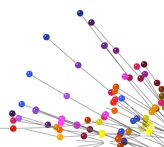
Welcome to the Lovell Lab
We try to understand how complex biological functions arise from molecules, their three dimensional shapes and their interactions. We also try to understand the origins of these functions and how they evolve.
We tackle this problem in a number of ways. These include:
1. The relationship between protein sequence and structure. This includes projects to improve ab intio protein folding methods, analyses of constraint on sequence evolution from protein structure and development of methods to identify coevolution at the molecular level.
2. How proteins interact with other molecules, especially other proteins. Almost all proteins function through the formation of protein-protein interactions. We aim to understand the determinants of interaction specificity, and how this specificity evolves.
3. How large collections of these interactions give rise to complex functional systems. This includes not only protein-protein interactions, but integration of a range of data types and analysis of the resulting complex models of systems.
4. Evolution of complex biological systems. Systems evolve through a range of mechanisms, including gene duplication and change of function. We have developed methods that allows us to understand these processes and place them in the context of the phylogenetic tree.
We use computational methods to study these biological problems. We also have interactions with experimental groups, and so have a range of interdisciplinary projects. We also work on a range of biological systems, incluing HIV and yeast.
Interested in joining the lab? Details are here










